
Dudleya virens, the green liveforever or bright green dudleya, is an uncommon species of perennial, succulent plant in the family Crassulaceae, native to several coastal southern California and Baja California locations.

Dudleya, commonly known as liveforevers is a genus of succulent plants in the stonecrop family, Crassulaceae, consisting of about 68 taxa in southwestern North America. The species come in multiple forms, some large and evergreen, others cryptic and deciduous. The flowers of Dudleya have parts numbered in 5, and when fruiting are filled with tiny, ovoid or crescent-shaped seeds. Dudleya are the only members of the Sedeae tribe that have sympodial branching.
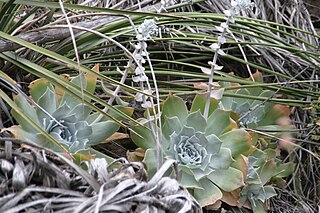
Dudleya pulverulenta is a species of perennial succulent plant known by the common names chalk lettuce, chalk dudleya, and chalk liveforever. Native to California and Baja California, it is one of the larger Dudleya, with a silvery, waxy rosette that may greatly contrast with its habitat.

Dudleya variegata is a succulent plant known by the common name variegated liveforever or variegated dudleya. It is native to Baja California and adjacent San Diego County in California, where it grows in several habitat types, including chaparral and vernal pools.
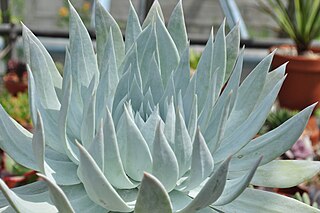
Dudleya brittonii, with the common names Britton's dudleya, Britton's liveforever and giant chalk dudleya, is a succulent plant in the family Crassulaceae. It is native to the coast of northern Baja California, Mexico. Both forms of the plant have yellow leaves on a clustered rosette atop a large reddish-purple peduncle. The white form of the plant has a chalky epicuticular wax that reflects light and reacts with water. The green form of the plant is more common and found throughout a wider range. It is among the largest of the Dudleya.
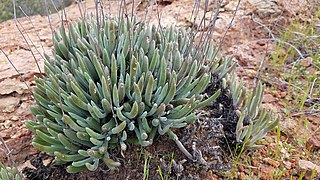
Dudleya attenuata, known by common name as the taper-tip liveforever, is a species of perennial succulent plant native to Baja California and a small portion of California. It is a diverse, polymorphic and frequently hybridizing species that extends from the southernmost coast of San Diego County to an area slightly north of the Vizcaino Desert. Some plants are with varying flowers are referred to as Orcutt's liveforever.

Dudleya ingens, commonly known as the Baja liveforever and the rock liveforever, is a species of succulent plant native to Baja California.

Dudleya anthonyi, known by the common name San Quintín liveforever, is a succulent plant endemic to the San Quintín volcanic field, located on Isla San Martín and the adjacent mainland bay of Bahia San Quintín, within Baja California.

Dudleya rigida, known commonly as the La Laguna liveforever, is a species of succulent perennial plant in the family Crassulaceae endemic to the Sierra de la Laguna in Baja California Sur, Mexico.

Dudleya anomala is a species of succulent plant known by the common name Todos Santos liveforever native to Baja California. It has sticky foliage, small, narrow leaves, spreading petals, and is found primarily on islands.

Dudleya pauciflora is a species of succulent plant known by the common name few-flower liveforever. It is native to the Baja California Peninsula.

Dudleya pachyphytum is an insular succulent plant known by the common name Cedros Island liveforever. It is a member of the genus Dudleya endemic to the foggy northern end of Cedros Island, occupying an ecological niche shared with the Cedros Island Pine. The plant is threatened by poaching from organized criminals, including South Korean nationals and criminal gangs operating under the Mexican cartels. Demand from succulent collectors in East Asia have led to overexploitation of the plant in the wild, and armed conflict between competing poachers has sparked killings of several people.

Dudleya linearis is an insular succulent plant known by common name as the San Benitos Liveforever. It is endemic to the San Benito Islands, a small group of Mexican islands in the Pacific Ocean, west of Cedros Island. The population was almost wiped out by rabbits introduced to the island.
Dudleya formosa, known by the common name La Misión liveforever, is a species of perennial succulent plant endemic to the Guadalupe Valley in Baja California. It is characterized by bright green leaves, red floral stems, and pink flowers.

Dudleya cultrata, commonly known as the knife-leaved liveforever or the maritime succulent liveforever, is a species of perennial succulent plant native to Baja California.

Dudleya arizonica, commonly known as the Arizona chalk dudleya and the Arizona liveforever, is a species of perennial succulent plant native to the southwestern United States and northwestern Mexico. It is one of two species of Dudleya that occur in Arizona, the other being Dudleya saxosa subsp. collomiae.
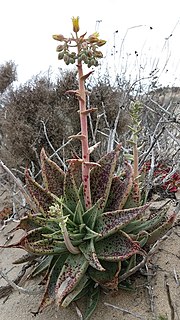
Dudleya acuminata, known by common name as the Vizcaino liveforever, is a species of succulent perennial plant in the family Crassulaceae native to the Baja California Peninsula and neighboring islands.
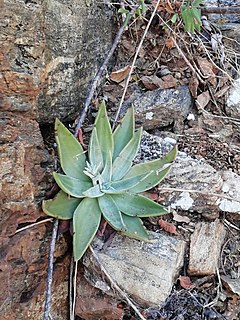
Dudleya nubigena is a species of succulent plants in the family Crassulaceae. It is a rosette forming perennial with flattish leaves. Endemic to southern Baja California Sur, the species is found in the Sierra de la Laguna and the surrounding lowlands, and on Cerralvo Island.
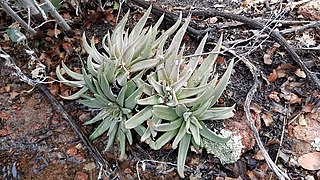
Dudleya abramsii subsp. abramsii is a succulent plant known by the common name Abrams' liveforever, native to the southern Sierra Nevada and the Peninsular Ranges across both the United States and Mexico. It is a small, delicate plant found growing among rocks.

Dudleya albiflora, known by the common name white-flower liveforever, is a species of succulent perennial plant in the family Crassulaceae. It is native to the Baja California Peninsula. This species represents numerous populations with varying chromosome numbers scattered around the peninsula, but all share common morphological traits such as white flowers and narrow leaves.


















